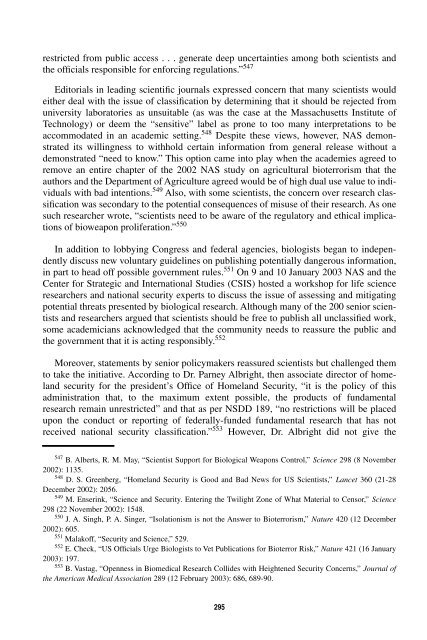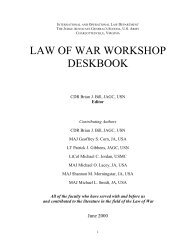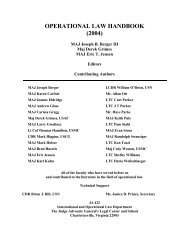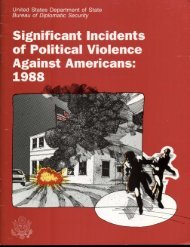learning with professionals - Higgins Counterterrorism Research ...
learning with professionals - Higgins Counterterrorism Research ...
learning with professionals - Higgins Counterterrorism Research ...
You also want an ePaper? Increase the reach of your titles
YUMPU automatically turns print PDFs into web optimized ePapers that Google loves.
estricted from public access . . . generate deep uncertainties among both scientists and<br />
the officials responsible for enforcing regulations.” 547<br />
Editorials in leading scientific journals expressed concern that many scientists would<br />
either deal <strong>with</strong> the issue of classification by determining that it should be rejected from<br />
university laboratories as unsuitable (as was the case at the Massachusetts Institute of<br />
Technology) or deem the “sensitive” label as prone to too many interpretations to be<br />
accommodated in an academic setting. 548 Despite these views, however, NAS demonstrated<br />
its willingness to <strong>with</strong>hold certain information from general release <strong>with</strong>out a<br />
demonstrated “need to know.” This option came into play when the academies agreed to<br />
remove an entire chapter of the 2002 NAS study on agricultural bioterrorism that the<br />
authors and the Department of Agriculture agreed would be of high dual use value to individuals<br />
<strong>with</strong> bad intentions. 549 Also, <strong>with</strong> some scientists, the concern over research classification<br />
was secondary to the potential consequences of misuse of their research. As one<br />
such researcher wrote, “scientists need to be aware of the regulatory and ethical implications<br />
of bioweapon proliferation.” 550<br />
In addition to lobbying Congress and federal agencies, biologists began to independently<br />
discuss new voluntary guidelines on publishing potentially dangerous information,<br />
in part to head off possible government rules. 551 On 9 and 10 January 2003 NAS and the<br />
Center for Strategic and International Studies (CSIS) hosted a workshop for life science<br />
researchers and national security experts to discuss the issue of assessing and mitigating<br />
potential threats presented by biological research. Although many of the 200 senior scientists<br />
and researchers argued that scientists should be free to publish all unclassified work,<br />
some academicians acknowledged that the community needs to reassure the public and<br />
the government that it is acting responsibly. 552<br />
Moreover, statements by senior policymakers reassured scientists but challenged them<br />
to take the initiative. According to Dr. Parney Albright, then associate director of homeland<br />
security for the president’s Office of Homeland Security, “it is the policy of this<br />
administration that, to the maximum extent possible, the products of fundamental<br />
research remain unrestricted” and that as per NSDD 189, “no restrictions will be placed<br />
upon the conduct or reporting of federally-funded fundamental research that has not<br />
received national security classification.” 553 However, Dr. Albright did not give the<br />
547 B. Alberts, R. M. May, “Scientist Support for Biological Weapons Control,” Science 298 (8 November<br />
2002): 1135.<br />
548 D. S. Greenberg, “Homeland Security is Good and Bad News for US Scientists,” Lancet 360 (21-28<br />
December 2002): 2056.<br />
549 M. Enserink, “Science and Security. Entering the Twilight Zone of What Material to Censor,” Science<br />
298 (22 November 2002): 1548.<br />
550 J. A. Singh, P. A. Singer, “Isolationism is not the Answer to Bioterrorism,” Nature 420 (12 December<br />
2002): 605.<br />
551 Malakoff, “Security and Science,” 529.<br />
552 E. Check, “US Officials Urge Biologists to Vet Publications for Bioterror Risk,” Nature 421 (16 January<br />
2003): 197.<br />
553 B. Vastag, “Openness in Biomedical <strong>Research</strong> Collides <strong>with</strong> Heightened Security Concerns,” Journal of<br />
the American Medical Association 289 (12 February 2003): 686, 689-90.<br />
295

















